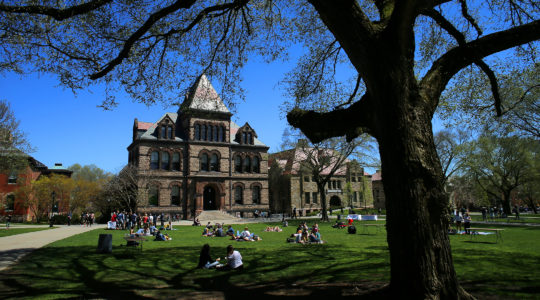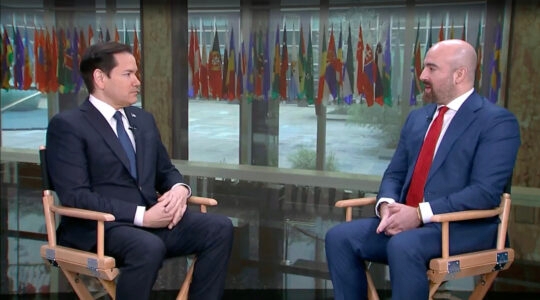GREENSBORO, N.C. (JTA) — Sitting at an oblong table, 11 students, each with a school-provided computer tablet, discuss John Steinbeck’s “Of Mice and Men,” parse the four types of classic love and veer off into talk about sex — all the while interrupting each other and their teacher.
These ninth-graders attend the American Hebrew Academy, a Jewish pluralistic boarding school in Greensboro, N.C., that is trying to reach the status of highly ranked Jewish high schools such as Gann Academy in Boston or the Ramaz School in New York City, as well as elite college preparatory boarding schools like Phillips Academy Andover in Massachusetts or Choate Rosemary Hall in Connecticut.
To achieve that aim, AHA, the only school of its kind in the United States, has a 100-acre campus, technology-filled classrooms, an athletic complex surrounded by sports fields and courts, students hailing from as far away as Thailand and Russia, and a faculty in which two of every three teachers has a graduate degree. About 20 percent of the teachers have doctorates.
“The goal of the school was to create a single place in which Jewish teens of all backgrounds could come together to live and learn,” said Glenn Drew, the academy’s executive director.
But as Drew himself noted, the school faces major challenges, inherent in its mission, that have prevented it from becoming the top destination for the country’s best and brightest Jewish students. More than 10 years after its founding, only 160 students attend AHA — far short of the 400 Drew hopes will one day fill the campus.
Unlike other pluralistic Jewish schools, AHA asks parents to send their children far from home and far from a major Jewish population center for four years.
And unlike other Jewish schools that accept boarders, such as the Orthodox Fasman Yeshiva High School near Chicago or the Yeshiva University High School for Boys in New York, AHA does not cater to students from one stream of Judaism in particular — meaning that parents cannot be certain that the school will reinforce their home’s Jewish practice.
While all students must attend Sabbath morning services, the services have ranged from rock climbing to traditional Orthodox worship.
“I’m sure students who come from a traditional background have peer pressure,” said Yosef Plotkin, the local Chabad rabbi, who teaches at AHA. “Your roommate may not be Shabbat observant, which can cause a big challenge. But overall the students are very respectful.”
As a young and small school, AHA also doesn’t have a deep base of alumni that it can tap for fundraising. Its founder, commercial aviation reinsurance mogul Maurice “Chico” Sabbah, who died in 2006, donated more than $100 million to the school and paid the tuition of the school’s initial 77 students. The school set aside $1.5 million for scholarships last year and for the coming school year. Last school term it still had to turn away 23 accepted students who could not afford the tuition of $31,000, including room and board.
AHA, which runs on a $10 million annual budget, has not increased its tuition for this term. Students who live in the area and commute pay $19,000.
The tuition falls in a normal range for American Jewish high schools. Students at Gann will pay $34,350 this school year, for example, while students at the Weber School in Atlanta will pay $23,730.
To help with its fundraising, AHA released an advertisement featuring the endorsement of Jewish mega-philanthropist Michael Steinhardt, who helped found Birthright Israel and sits on the academy’s board of trustees. In 2009, Steinhardt gave $5 million to AHA.
“There’s no telling how many people learn about the academy and its cost, and automatically presume that the academy is beyond their means,” Drew said. He added, however, “When you look at the price of day schools in the larger cities compared to the American Hebrew Academy, you begin to question the value that you’re getting” at the day schools.
Drew says the school is not in direct competition with local Jewish high schools. Many AHA students come from areas with only one or no Jewish high schools, and a growing percentage is international.
In addition to its course offerings, which range from plant biology in a botany lab to Basics of Fashion and Costume Design, from Holocaust and Human Behavior to Kabbalah and Jewish Mysticism, AHA’s curriculum encourages students to stay physically fit. The school requires intensive physical and health education all four years, and hosts more than a dozen varsity, intramural and club sports teams.
“There’s always this ambitious point here,” said Jimmy Gozal, a senior from Madrid, Spain. “You get good grades here, they’ll admire you. Here they want you to do stuff.”
Gozal comes from an Orthodox Jewish community in which “there’s no Reform, no Conservative, nothing.” He says the school’s pluralistic community and focus on interdenominational dialogue have introduced him to new ways of practicing and thinking about Judaism.
Students at AHA rarely segregate by denomination, and they take classes on a range of Jewish philosophical perspectives. Dinner is followed by a mandatory two-hour study period — a schedule that leaves the students with little unstructured time.
“Coming to a school where every second of every day was regulated, all of that is something you had to get used to,” said rising senior Jennifer Von Ende. “That was a struggle. It made me into a better student.”
Drew expects that by the 2013-14 school year, 200 students will attend the school. While he acknowledges that AHA isn’t for every Jewish student, he also hopes that more Jewish teens — and their parents — at least will know what it is.
“There’s no limit to what the academy has to do to in terms of raising awareness of its institution,” Drew said. “For families of major metropolitan cities, when they are looking at options for their children’s Jewish high school education, the academy simply wants to be among those options.”
JTA has documented Jewish history in real-time for over a century. Keep our journalism strong by joining us in supporting independent, award-winning reporting.





